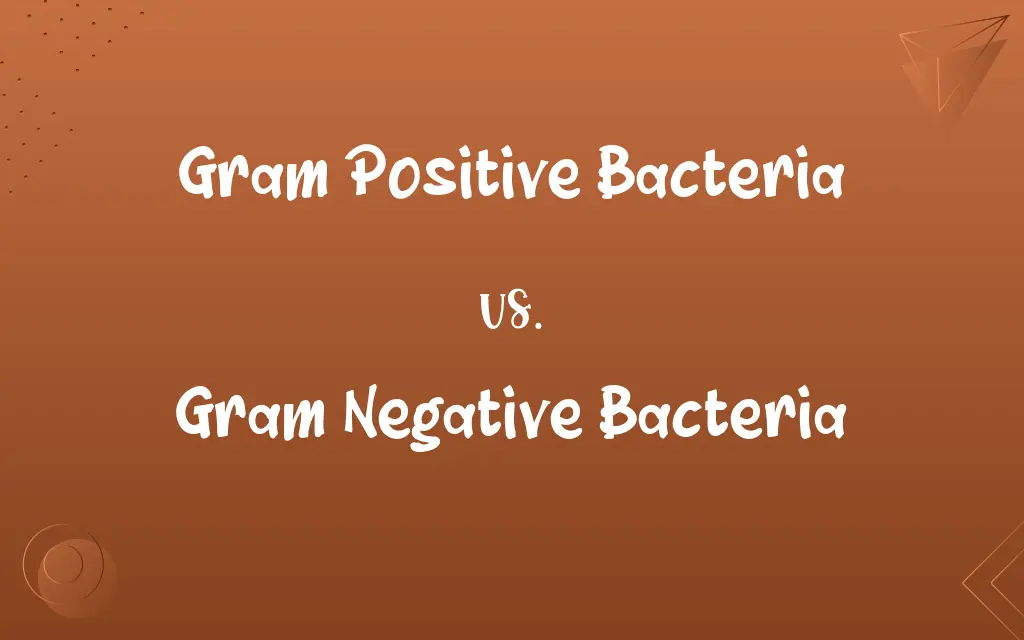Gram Positive Bacteria vs. Gram Negative Bacteria: Know the Difference

By Shumaila Saeed || Updated on December 25, 2023
Gram Positive Bacteria have thick peptidoglycan cell walls, staining purple; Gram Negative Bacteria have thin cell walls with outer membranes, staining pink.

Key Differences
Gram Positive Bacteria are characterized by thick peptidoglycan layers in their cell walls, which absorb the crystal violet stain used in Gram staining, appearing purple. In contrast, Gram Negative Bacteria have a thinner peptidoglycan layer and an additional outer membrane, which does not retain the crystal violet stain, leading them to appear pink or red after the staining process.
Shumaila Saeed
Dec 17, 2023
In terms of susceptibility to antibiotics, Gram Positive Bacteria, due to their simpler wall structure, are generally more susceptible to antibiotics that target cell walls. Conversely, Gram Negative Bacteria, with their complex outer membrane, can be more resistant to such antibiotics, often requiring different treatment approaches.
Shumaila Saeed
Dec 17, 2023
The structural differences between Gram Positive and Gram Negative Bacteria also influence their responses to mechanical and osmotic pressure. Gram Positive Bacteria, with their robust cell walls, are typically more resilient to physical stresses. On the other hand, Gram Negative Bacteria, with their additional outer membranes, have evolved mechanisms to protect against chemical and environmental challenges.
Shumaila Saeed
Dec 17, 2023
From an immunological perspective, Gram Positive Bacteria are known for their exposure of teichoic acids on the cell wall, which can trigger specific immune responses. In contrast, Gram Negative Bacteria often release lipopolysaccharides (LPS), especially when they die, which can provoke strong immune reactions, sometimes leading to septic shock.
Shumaila Saeed
Dec 17, 2023
In the realm of environmental adaptation, Gram Positive Bacteria are commonly found in environments ranging from soil to the human body. In comparison, Gram Negative Bacteria are notably diverse, inhabiting environments from the human gut to extreme habitats, thanks to their adaptable cell envelope structure.
Shumaila Saeed
Dec 17, 2023
ADVERTISEMENT
Comparison Chart
Cell Wall Thickness
Thick peptidoglycan layer
Thin peptidoglycan layer with outer membrane
Shumaila Saeed
Dec 17, 2023
Gram Stain Reaction
Retain crystal violet stain, appear purple
Do not retain crystal violet, appear pink or red
Shumaila Saeed
Dec 17, 2023
Antibiotic Susceptibility
Generally more susceptible to certain antibiotics
Often more resistant due to outer membrane
Shumaila Saeed
Dec 17, 2023
Immunological Response Trigger
Exposure of teichoic acids
Release of lipopolysaccharides (LPS)
Shumaila Saeed
Dec 17, 2023
Environmental Adaptability
Found in diverse environments, including soil
Extremely adaptable, from human gut to extreme habitats
Shumaila Saeed
Dec 17, 2023
ADVERTISEMENT
Gram Positive Bacteria and Gram Negative Bacteria Definitions
Gram Positive Bacteria
These bacteria play roles in both beneficial and pathogenic interactions with hosts.
Lactobacillus, a Gram Positive Bacterium, is beneficial for gut health.
Shumaila Saeed
Dec 11, 2023
Gram Negative Bacteria
Gram Negative Bacteria are characterized by a thin peptidoglycan layer and an outer membrane.
E. coli, a Gram Negative Bacterium, is commonly found in the human intestine.
Shumaila Saeed
Dec 11, 2023
Gram Positive Bacteria
These bacteria lack an outer membrane, characteristic of their simple cell wall structure.
Staphylococcus aureus, a Gram Positive Bacterium, is often found on human skin.
Shumaila Saeed
Dec 11, 2023
Gram Negative Bacteria
They do not retain the crystal violet stain in Gram staining, appearing pink or red.
Salmonella, a Gram Negative Bacterium, is known for causing food poisoning.
Shumaila Saeed
Dec 11, 2023
Gram Positive Bacteria
Gram Positive Bacteria often release exotoxins, which can be potent toxins affecting health.
Bacillus anthracis, a Gram Positive Bacterium, produces toxins causing anthrax.
Shumaila Saeed
Dec 11, 2023
ADVERTISEMENT
Gram Negative Bacteria
They are diverse and adapt to various environments, from the human body to extreme conditions.
Helicobacter pylori, a Gram Negative Bacterium, can survive the acidic environment of the stomach.
Shumaila Saeed
Dec 11, 2023
Gram Positive Bacteria
Gram Positive Bacteria are microbes with thick peptidoglycan cell walls that stain purple in Gram staining.
Streptococcus pneumoniae, a Gram Positive Bacterium, is known to cause pneumonia.
Shumaila Saeed
Dec 11, 2023
Gram Negative Bacteria
These bacteria are often more resistant to antibiotics due to their complex cell envelope.
Pseudomonas aeruginosa, a Gram Negative Bacterium, is known for its antibiotic resistance.
Shumaila Saeed
Dec 11, 2023
Gram Positive Bacteria
They are generally more susceptible to antibiotics that target cell walls.
Penicillin is effective against many Gram Positive Bacteria, such as Streptococcus.
Shumaila Saeed
Dec 11, 2023
Gram Negative Bacteria
Gram Negative Bacteria can release endotoxins, especially lipopolysaccharides (LPS).
Neisseria meningitidis, a Gram Negative Bacterium, releases endotoxins causing meningitis.
Shumaila Saeed
Dec 11, 2023
Repeatedly Asked Queries
How do Gram Positive Bacteria react to antibiotics?
They are generally more susceptible to antibiotics targeting cell walls.
Shumaila Saeed
Dec 17, 2023
What toxins do Gram Positive Bacteria release?
They often release exotoxins, which can be potent.
Shumaila Saeed
Dec 17, 2023
Are Gram Negative Bacteria resistant to certain antibiotics?
Yes, their complex cell envelope can confer increased resistance.
Shumaila Saeed
Dec 17, 2023
What defines Gram Positive Bacteria?
They have a thick peptidoglycan cell wall and stain purple in Gram staining.
Shumaila Saeed
Dec 17, 2023
What environments do Gram Negative Bacteria inhabit?
They adapt to a wide range, from human bodies to extreme habitats.
Shumaila Saeed
Dec 17, 2023
How do Gram Negative Bacteria affect the immune system?
They can provoke strong reactions, sometimes leading to septic shock.
Shumaila Saeed
Dec 17, 2023
What are Gram Negative Bacteria characterized by?
They have a thin peptidoglycan layer and an additional outer membrane, staining pink or red in Gram staining.
Shumaila Saeed
Dec 17, 2023
Is it easy to differentiate these bacteria under a microscope?
Yes, Gram Positive appear purple and Gram Negative appear pink or red.
Shumaila Saeed
Dec 17, 2023
Do both bacteria types have the same cell wall structure?
No, Gram Positive have a simpler, thicker wall, while Gram Negative have a complex, thinner wall with an outer membrane.
Shumaila Saeed
Dec 17, 2023
Do Gram Negative Bacteria release toxins?
Yes, they release endotoxins like lipopolysaccharides (LPS).
Shumaila Saeed
Dec 17, 2023
Can Gram Positive Bacteria be beneficial?
Yes, some, like Lactobacillus, are beneficial for health.
Shumaila Saeed
Dec 17, 2023
Are Gram Negative Bacteria always harmful?
No, some are harmless or beneficial, like gut flora.
Shumaila Saeed
Dec 17, 2023
How do Gram Negative Bacteria protect against environmental challenges?
Their outer membrane offers protection against chemical and environmental stresses.
Shumaila Saeed
Dec 17, 2023
Where are Gram Positive Bacteria commonly found?
In diverse environments, including soil and the human body.
Shumaila Saeed
Dec 17, 2023
What immune response do Gram Positive Bacteria trigger?
They can trigger responses through teichoic acids exposure.
Shumaila Saeed
Dec 17, 2023
Are Gram Positive Bacteria more robust to physical stress?
Yes, their thick cell walls provide resilience to stress.
Shumaila Saeed
Dec 17, 2023
What diseases are associated with Gram Negative Bacteria?
They are linked to conditions like meningitis and food poisoning.
Shumaila Saeed
Dec 17, 2023
Can Gram Positive Bacteria cause serious diseases?
Yes, they can cause diseases like pneumonia and anthrax.
Shumaila Saeed
Dec 17, 2023
How is Gram staining done?
It involves staining bacteria with crystal violet and a counterstain.
Shumaila Saeed
Dec 17, 2023
Are both types of bacteria equally common in nature?
Both are widespread, but their distribution varies depending on the environment.
Shumaila Saeed
Dec 17, 2023
Share this page
Link for your blog / website
HTML
Link to share via messenger
About Author
Written by
Shumaila SaeedShumaila Saeed, an expert content creator with 6 years of experience, specializes in distilling complex topics into easily digestible comparisons, shining a light on the nuances that both inform and educate readers with clarity and accuracy.









































































